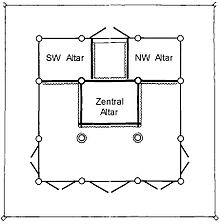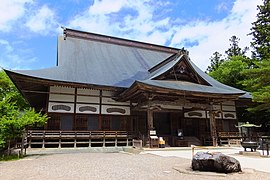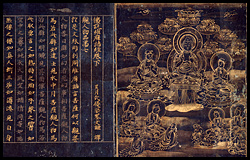Chūson-ji
Chūson-ji ( Japanese 中 尊 寺 ) is a Buddhist temple in Hiraizumi , Iwate Prefecture . It is the main temple of the Tendai sect in Tōhoku (northeastern Japan). Chūson-ji was built by Fujiwara no Kiyohira ( 藤原 清 衡 ; 1056–1128) around 1100 on a somewhat remote hill. The temple is famous for its magnificent "Golden Hall".
Temple complex
Golden Hall
The Golden Hall ( 金色 堂 , Konjikidō ) ( National Treasure ) is a mausoleum that was completed in 1124. It houses the mummified remains of the leading figures of the northern Fujiwara branch ( 奥 州 藤原 氏 , Ōshū Fujiwara-shi or 陸 奥 藤原 氏 , Mutsu Fujiwara-shi) who ruled this area. The wooden building, with a square floor plan of 5.5 × 5.5 m and 8 m high, is gilded on the inside. It contains an ensemble of three raised altars under a kind of canopy supported by four columns. Of the 33 figures that adorn each of the three altars in groups of 11, all but one have been preserved:
- In the middle there is a seated Amida Nyorai Buddha, flanked on the right and left
- from a standing Kannon Bosatsu and a standing Seishi Bosatsu as well
- of six jizō , three each on the right and left and
- front protected by two of the four kings of heaven ( Shitennō ), namely Jikoku-ten ( 持 国 天 ) and Zōjō-ten ( 増 長 天 ).
The inside of the whole hall is covered with black lacquer, in which gilding and mother-of-pearl decorations have been incorporated with great wealth of details. The phoenix or peacock is a motif on the altar pedestal. The use of Asian rosewood and African ivory is evidence of the extensive trade relations of the time.
The mummies were last examined in 1950. It is believed that Fujiwara no Kiyohira was laid under the central altar. Son Fujiwara no Motohira ( 藤原 基 衡 ; † 1057) could be identified because it is known that he died of a bruise in his head. It is located in the northwest altar. His son Fujiwara no Hidehira ( 藤原 秀 衡 ; 1096–1187), supporter of Minamoto no Yoritomo , was found under the southwest altar, next to a container that contains the head of his son Yasuhira ( 藤原 康 衡 ; † 1089), which is in lost his life in the conflict with Yoritomo in 1189.
Extensive restoration work was carried out between 1962 and 1968. The building from the Muromachi period , which was exposed to wind and weather for about 500 years, was dismantled and rebuilt a few 100 m away - now within a shelter. The altars were also restored so that they show their original beauty. However, the hall is now separated by an acrylic pane, so that the inside can only be viewed from the front.
Matsuo Bashō visited the temple in 1689 and noted "Early summer rain / fell and remained there / Shiny hall."
main building
The main building ( 本 堂 , Hondō ) dates from 1909. All services and other religious events take place in this building. Here guests can copy sutras and take part in Zen meditations.
Sutr memory
The sutrenspeicher ( 経 蔵 , Kyōzō ) next to the Golden Hall also comes from the Fujiwara period. It housed the extremely valuable collection of transcripts of sutra known as "Chūsonji Sutras". They are written on indigo paper in gold ink.
museum
The museum, here called Sankōzō ( 讃 衡 蔵 ), houses more than 3000 objects. The current building dates from 2000 and presents selected pieces, including excerpts from the Chūsonji sutras.
In 1979 the complex was declared a special historical site ( tokubetsu shiseki ). In June 2011, the Chūson-ji was added to the World Heritage List as part of the "Historical Monuments and Complexes of Hiraizumi" .
gallery
Individual evidence
- ↑ Sawa, R. (Ed.): Butsuzo annai. Furukawa Kobunkan, 18th edition 1992. ISBN 4-642-07206-3 . P. 66
- ^ A b E. Papinot: Historical and Geographical Dictionary of Japan. Reprint of the original 1910 edition by Tuttle, 1972. ISBN 0-8048-0996-8 .
Remarks
- ↑ Construction Hōgyō-zukuri ( 方形 造 , also: 宝 形 造 )
- ↑ One of the Kings of Heaven was lost on the southwest altar.
- ↑ 勢 至 菩薩 . She can hardly be distinguished from a Kannon and is not worshiped alone.
- ↑ 「五月 雨 の 降 (ふ り) 残 し て や 光 堂」
literature
- Folder of the temple
- Ōga Tetsuo (Ed.): Meihō Nihon no bijutsu 9. Byōdōin to Chūsonji Shōgakuken 1982.
Web links
- Official Chūson-ji website Japanese
- Official Chūson-ji website English
- Entry on the UNESCO World Heritage Center website ( English and French ).






